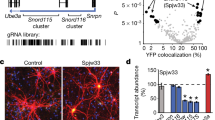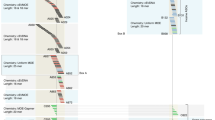Abstract
Angelman syndrome is a single-gene disorder characterized by intellectual disability, developmental delay, behavioural uniqueness, speech impairment, seizures and ataxia1,2. It is caused by maternal deficiency of the imprinted gene UBE3A, encoding an E3 ubiquitin ligase3,4,5. All patients carry at least one copy of paternal UBE3A, which is intact but silenced by a nuclear-localized long non-coding RNA, UBE3A antisense transcript (UBE3A-ATS)6,7,8. Murine Ube3a-ATS reduction by either transcription termination or topoisomerase I inhibition has been shown to increase paternal Ube3a expression9,10. Despite a clear understanding of the disease-causing event in Angelman syndrome and the potential to harness the intact paternal allele to correct the disease, no gene-specific treatment exists for patients. Here we developed a potential therapeutic intervention for Angelman syndrome by reducing Ube3a-ATS with antisense oligonucleotides (ASOs). ASO treatment achieved specific reduction of Ube3a-ATS and sustained unsilencing of paternal Ube3a in neurons in vitro and in vivo. Partial restoration of UBE3A protein in an Angelman syndrome mouse model ameliorated some cognitive deficits associated with the disease. Although additional studies of phenotypic correction are needed, we have developed a sequence-specific and clinically feasible method to activate expression of the paternal Ube3a allele.
This is a preview of subscription content, access via your institution
Access options
Subscribe to this journal
Receive 51 print issues and online access
$199.00 per year
only $3.90 per issue
Buy this article
- Purchase on Springer Link
- Instant access to full article PDF
Prices may be subject to local taxes which are calculated during checkout




Similar content being viewed by others
References
Dagli, A., Buiting, K. & Williams, C. A. Molecular and clinical aspects of Angelman ayndrome. Mol. Syndromol. 2, 100–112 (2012)
Williams, C. A., Driscoll, D. J. & Dagli, A. I. Clinical and genetic aspects of Angelman syndrome. Genet. Med. 12, 385–395 (2010)
Kishino, T., Lalande, M. & Wagstaff, J. UBE3A/E6-AP mutations cause Angelman syndrome. Nature Genet. 15, 70–73 (1997)
Matsuura, T. et al. De novo truncating mutations in E6-AP ubiquitin-protein ligase gene (UBE3A) in Angelman syndrome. Nature Genet. 15, 74–77 (1997)
Albrecht, U. et al. Imprinted expression of the murine Angelman syndrome gene, Ube3a, in hippocampal and Purkinje neurons. Nature Genet. 17, 75–78 (1997)
Rougeulle, C., Cardoso, C., Fontes, M., Colleaux, L. & Lalande, M. An imprinted antisense RNA overlaps UBE3A and a second maternally expressed transcript. Nature Genet. 19, 15–16 (1998)
Chamberlain, S. J. & Brannan, C. I. The Prader–Willi syndrome imprinting center activates the paternally expressed murine Ube3a antisense transcript but represses paternal Ube3a. Genomics 73, 316–322 (2001)
Meng, L., Person, R. E. & Beaudet, A. L. Ube3a-ATS is an atypical RNA polymerase II transcript that represses the paternal expression of Ube3a. Hum. Mol. Genet. 21, 3001–3012 (2012)
Meng, L. et al. Truncation of Ube3a-ATS unsilences paternal Ube3a and ameliorates behavioral defects in the Angelman syndrome mouse model. PLoS Genet. 9, e1004039 (2013)
Huang, H. S. et al. Topoisomerase inhibitors unsilence the dormant allele of Ube3a in neurons. Nature 481, 185–189 (2012)
Wu, H. et al. Determination of the role of the human RNase H1 in the pharmacology of DNA-like antisense drugs. J. Biol. Chem. 279, 17181–17189 (2004)
Dindot, S. V., Antalffy, B. A., Bhattacharjee, M. B. & Beaudet, A. L. The Angelman syndrome ubiquitin ligase localizes to the synapse and nucleus, and maternal deficiency results in abnormal dendritic spine morphology. Hum. Mol. Genet. 17, 111–118 (2008)
Cassidy, S. B., Schwartz, S., Miller, J. L. & Driscoll, D. J. Prader–Willi syndrome. Genet. Med. 14, 10–26 (2012)
King, I. F. et al. Topoisomerases facilitate transcription of long genes linked to autism. Nature 501, 58–62 (2013)
Jiang, Y. H. et al. Mutation of the Angelman ubiquitin ligase in mice causes increased cytoplasmic p53 and deficits of contextual learning and long-term potentiation. Neuron 21, 799–811 (1998)
Kordasiewicz, H. B. et al. Sustained therapeutic reversal of Huntington’s disease by transient repression of huntingtin synthesis. Neuron 74, 1031–1044 (2012)
Rigo, F. et al. Pharmacology of a central nervous system delivered 2′-O-methoxyethyl-modified survival of motor neuron splicing oligonucleotide in mice and nonhuman primates. J. Pharmacol. Exp. Ther. 350, 46–55 (2014)
Cattanach, B. M. et al. A candidate model for Angelman syndrome in the mouse. Mamm. Genome 8, 472–478 (1997)
Allensworth, M., Saha, A., Reiter, L. T. & Heck, D. H. Normal social seeking behavior, hypoactivity and reduced exploratory range in a mouse model of Angelman syndrome. BMC Genet. 12, 7 (2011)
Huang, H. S. et al. Behavioral deficits in an Angelman syndrome model: effects of genetic background and age. Behav. Brain Res. 243, 79–90 (2013)
Smith, R. A. et al. Antisense oligonucleotide therapy for neurodegenerative disease. J. Clin. Invest. 116, 2290–2296 (2006)
Miller, T. M. et al. An antisense oligonucleotide against SOD1 delivered intrathecally for patients with SOD1 familial amyotrophic lateral sclerosis: a phase 1, randomised, first-in-man study. Lancet Neurol. 12, 435–442 (2013)
Chiriboga, C. et al. Results of an open-label, escalating dose study to assess the safety, tolerability, and dose range finding of a single intrathecal dose of ISIS-SMNRx in patients with spinal muscular atrophy. 65th American Academy of Neurology Annual Meeting Abstract S36.002. (2013)
Swayze, E. E. et al. Antisense oligonucleotides containing locked nucleic acid improve potency but cause significant hepatotoxicity in animals. Nucleic Acids Res. 35, 687–700 (2007)
Lagier-Tourenne, C. et al. Targeted degradation of sense and antisense C9orf72 RNA foci as therapy for ALS and frontotemporal degeneration. Proc. Natl Acad. Sci. USA 110, E4530–E4539 (2013)
Butler, M., Stecker, K. & Bennett, C. F. Cellular distribution of phosphorothioate oligodeoxynucleotides in normal rodent tissues. Lab. Invest. 77, 379–388 (1997)
Acknowledgements
We thank T. Cooper for suggesting the collaboration between L.M., A.L.B. and Isis Pharmaceuticals. L.M. thanks D. Liu, X. Jun, H. Zheng, J. Rosen, C. Spencer and X. Zhai for technical support and reagent sharing, and M. Costa-Mattioli, J. Jankowsky and Y. Elgersma for discussions. This research was supported by funding from National Institutes of Health grant R01 HD037283 (A.L.B.), the Angelman Syndrome Foundation (A.L.B. and L.M.), and Baylor College of Medicine Intellectual and Developmental Disability Research Center grant P30HD024064.
Author information
Authors and Affiliations
Contributions
L.M. and A.J.W. designed and performed experiments, analysed data, and wrote the paper (equal contribution). S.C. performed ASO delivery for Figure 2. C.F.B., A.L.B. and F.R. supervised the project. All authors discussed the experimental results.
Corresponding authors
Ethics declarations
Competing interests
A.J.W., C.F.B. and F.R. are employees of Isis Pharmaceuticals.
Extended data figures and tables
Extended Data Figure 1 ASOs targeting Snord116 reduced Ube3a-ATS pre-mRNA.
a, Top, schematic of the ASO-binding sites and location of qRT–PCR primer and probe sets. Bottom, qRT–PCR from wild-type primary neurons treated with ASO A or ASO116 (72 h) using primer and probe sets to the indicated regions of Ube3a-ATS pre-mRNA and mRNA. b, Nascent transcripts were isolated from wild-type primary neurons incubated with 5-ethynyl uridine (see Methods) for the indicated time. qRT–PCR for pre-mRNA and mature mRNA within the Snord116 region. The red line indicates the 30 min delay between the appearance of pre-mRNA and mature mRNA. Assuming a transcription elongation rate of 4 kb min−1, it would take RNAPII 80 min to transcribe the 332 kb distance from the last copy of Snord116 to the ASO-binding site. HG, host gene. n = 2 per group, mean ± absolute deviation.
Extended Data Figure 2 ASOs complementary to two regions of Ube3a-ATS differed in their ability to unsilence paternal Ube3a.
PatYFP primary neurons were treated with ASOs that bind Ube3a-ATS 5′ of Ube3a (non-overlap ASOs, n = 15) or that bind to the gene body region (overlap ASOs, n = 12) for 72 h. The level of Ube3aYFP-ATS reduction and Ube3aYFP upregulation was analysed by qRT–PCR and normalized to untreated control (UTC) neurons. Data are shown as mean ± s.e.m.
Extended Data Figure 3 In vivo ASO administration was well tolerated.
a, Left, body weight of individual wild-type C57BL/6 female mice (2 months old) treated with PBS or ASO measured weekly for 4 weeks after treatment. Right, change in body weight at each time point relative to body weight at time of treatment. n = 4 per group, mean ± s.e.m. b, Per cent change in body weight of PatYFP mice 4 weeks after treatment relative to pre-treatment. n = 3–4, mean ± s.e.m. c, Microglial activation was measured by Aif1 qRT–PCR 4 weeks after treatment. CTX, cortex; HIP, hippocampus; SC, thoracic spinal cord. *P < 0.05, two-tailed t-test, n = 3–4 per group, mean ± s.e.m. d, Immunohistochemistry for AIF1 and GFAP on sagittal brain sections from wild-type C57BL/6 female mice treated with PBS or ASO for 2 weeks.
Extended Data Figure 4 Snord116 was not reduced in the hypothalamus.
qRT–PCR on RNA isolated from PatYFP mice 4 weeks after treatment with PBS or ASO B.
Extended Data Figure 5 UBE3A unsilencing persisted 4 months after treatment.
ASO and YFP immunofluorescence on brain sections of cortex and cerebellum in PatYFP mice 4 months after treatment with ASO A.
Extended Data Figure 6 UBE3A–YFP was upregulated throughout the brain.
Whole-brain image of YFP fluorescence in PatYFP mice treated with PBS or ASO 4 weeks after treatment.
Extended Data Figure 7 Imaging of unsilenced UBE3A–YFP in specific brain regions.
a–l, Immunofluorescence for ASO, UBE3A–YFP and NeuN 4 weeks after treatment in MatYFP or PatYFP mice of the amygdala (a), hippocampus CA2 and CA3 layers (b), dentate gyrus (c), striatrum (d), thalamus (e), hypothalamus (f), medulla (g), third ventricle (h), motor cortex (i), somatosensory cortex (j), auditory cortex (k) and visual cortex (l).
Extended Data Figure 8 Intrahippocampal injection of ASO A in PatYFP mice resulted in near complete unsilencing of paternal UBE3A–YFP.
YFP immunofluorescence on brain sections from PatYFP mice treated with Ctl ASO, 100 μg ASO A via intrahippocampal injection, or 700 μg ASO A via ICV injection. A MatYFP mouse treated with PBS was included for comparison.
Extended Data Figure 9 ASO treatment in Angelman syndrome mice upregulated Ube3a.
a, RNA levels of Ube3a-ATS and Ube3a were determined by qRT–PCR in wild-type (WT) mice treated with PBS and Angelman syndrome (AS) mice treated with Ctl ASO or ASO A. n = 2–3 per group, mean ± s.e.m. b, UBE3A immunofluorescence on brain sections was performed 2 to 8 weeks after treatment. c–h, ASO treatment in adult Angelman syndrome mice did not reverse some disease-associated phenotypes. c, Total distance travelled in the open field assay. d, Vertical activity in the open field assay. e, Stereotype activity in the open field assay. f, Marble burying test. The y axis represents the number of marbles at least 50% buried. g, Accelerating rotarod test during eight trials. h, Post-shock and cued response measured during the fear conditioning assay. n = 13–15 per group *P < 0.05, ***P < 0.001 (one-way ANOVA with Newman–Keuls post-hoc analysis). NS, not significant. i, Growth curve of age-matched female mice. Each line represents weight measurements of a single mouse over a 5-month time course post-injection, n = 5 per group. Tx age, age of mouse at time of treatment.
Rights and permissions
About this article
Cite this article
Meng, L., Ward, A., Chun, S. et al. Towards a therapy for Angelman syndrome by targeting a long non-coding RNA. Nature 518, 409–412 (2015). https://doi.org/10.1038/nature13975
Received:
Accepted:
Published:
Issue Date:
DOI: https://doi.org/10.1038/nature13975
This article is cited by
-
Outcome measures in Angelman syndrome
Journal of Neurodevelopmental Disorders (2024)
-
Imprinting disorders
Nature Reviews Disease Primers (2023)
-
Contextual fear memory impairment in Angelman syndrome model mice is associated with altered transcriptional responses
Scientific Reports (2023)
-
Novel epigenetic molecular therapies for imprinting disorders
Molecular Psychiatry (2023)
-
Gain and loss of function variants in EZH1 disrupt neurogenesis and cause dominant and recessive neurodevelopmental disorders
Nature Communications (2023)
Comments
By submitting a comment you agree to abide by our Terms and Community Guidelines. If you find something abusive or that does not comply with our terms or guidelines please flag it as inappropriate.



